Nov 17, 2021
Posted by John Loop, Technology Manager
The Caterpillar Oil Aeration Test (ASTM D8047) is the standard test method to evaluate an oils resistance to aeration and is included within the ACEA 2022 Heavy-Duty Engine Oils Sequences upgrade. In this video, we discuss the test which is commonly referred to as the COAT.
For more information, please contact your Lubrizol representative.
Video Transcript
The Caterpillar oil aeration test evaluates aeration performance, in other words, and oil's ability to evacuate entrained air that is present in an oil as a contaminant.
This is especially important in regions of main and connecting rod bearings, as high concentrations of air could lead to oil starvation at these locations, catastrophic failure or significant wear.
Previous tests for air contamination the COAT uses hardware which is becoming scarce, and a procedure that exposes the engine technicians to hot oil. Unlike its predecessor, this test utilizes a continual circulation of lubricant to evaluate engine oil, aeration, contamination in real time and in situ. Apart from driving a truck down the road, this test is the closest thing to real world conditions.
The COAT is conducted in a 13 liter Caterpillar engine that will require approximately 1 drum or 55 gallons of test candidate because it is a flush and run test, determining air contamination through an oil sensor without having to remove the oil from the engine. This is different than most standardized engine test types where those require either a partial or full engine tear down and rebuild. In this test, the only thing that occurs in between each test run is an oil change and flushing. While the engine runs a portion of the test oil is diverted to a sensor called the Micro Motion to determine the oils density.
Oil flows freely to and through the Micro Motion and back into the engine throughout the entirety of the test, providing 50 hours of oil density data, and the test currently utilizes standardized test fuel PC-10, which is an ultra low Sulphur test grade diesel fuel. Also, the test does not use a dynameter to provide a counterforce against the torque of the engine because the test is simply to get the oil up to a typical running temperature and then have the crankcase splashed through the oil to create air contamination into the oil. The measurement of air contamination concentration in units of percent is averaged for the final ten hours of test duration.
Caterpillar decided that the acceptable level of air contamination is 11.8% based upon data when the test was introduced into API CK-4 and FA-4 in 2016. The COAT will be part of a E8 and E11, and that reason is because resistance to air contamination is still a significant part of the design of the next generation of crankcase lubricants.
If a lubricant can resist air contamination, it can function properly in the engine break. The end user benefits by having a safer vehicle that can stop quicker and with consistent and better fuel injection, thereby having a lower cost to fuel the engine.
What this means for the fleet owner and operators is enhanced protection and reliability of the equipment now as well as in the future.








